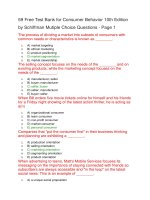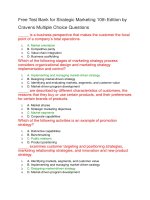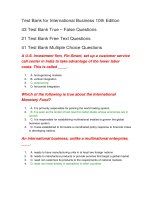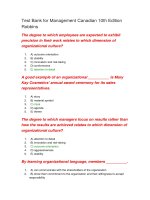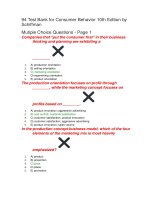Test bank for accounting principles 10th edition
Bạn đang xem bản rút gọn của tài liệu. Xem và tải ngay bản đầy đủ của tài liệu tại đây (254.25 KB, 49 trang )
Test Bank for Accounting Principles 10th Edition
A business organized as a corporation
1. a. is not a separate legal entity in most states.
2. b. requires that stockholders be personally liable for the debts of the
business.
3. c. is owned by its stockholders.
4. d. terminates when one of its original stockholders dies.
The partnership form of business organization
1. a. is a separate legal entity.
2. b. is a common form of organization for service-type businesses.
3. c. enjoys an unlimited life.
4. d. has limited liability.
Which of the following is not an advantage of the corporate form of business
organization?
1. a. Limited liability of stockholders
2. b. Transferability of ownership
3. c. Unlimited personal liability for stockholders
4. d. Unlimited life
A small neighborhood barber shop that is operated by its owner would likely
be organized as a
1. a. joint venture.
2. b. partnership.
3. c. corporation.
4. d. proprietorship.
John and Sam met at law school and decide to start a small law practice after
graduation. They agree to split revenues and expenses evenly. The most
common form of business organization for a business such as this would be
a
1. a. joint venture.
2. b. partnership.
3. c. corporation.
4. d. proprietorship.
Which of the following is true regarding the corporate form of business
organization?
1. a. Corporations are the most prevalent form of business organization.
2. b. Corporate businesses are generally smaller in size than partnerships and
proprietor-ships.
3. c. The revenues of corporations are greater than the combined revenues of
partnerships and proprietorships.
4. d. Corporations are separate legal entities organized exclusively under
federal law.
A basic assumption of accounting that requires activities of an entity be kept
separate from the activities of its owner is referred to as the
1. a. stand alone concept.
2. b. monetary unit assumption.
3. c. corporate form of ownership.
4. d. economic entity assumption.
Ted Leo is the proprietor (owner) of Ted's, a retailer of golf apparel. When
recording the financial transactions of Ted's, Ted does not record an entry for
a car he purchased for personal use. Ted took out a personal loan to pay for
the car. What accounting concept guides Ted's behavior in this situation?
1. a. Pay back concept
2. b. Economic entity assumption
3. c. Cash basis concept
4. d. Monetary unit assumption
A basic assumption of accounting assumes that the dollar is
1. a. unrelated to business transactions.
2. b. a poor measure of economic activities.
3. c. the common unit of measure for all business transactions.
4. d. useless in measuring an economic event.
The assumption that the unit of measure remains sufficiently constant over
time is part of the
1. a. economic entity assumption.
2. b. cost principle.
3. c. historical cost principle.
4. d. monetary unit assumption.
A business that enjoys limited liability is a
1. a. proprietorship.
2. b. partnership.
3. c. corporation.
4. d. sole proprietorship.
A problem with the monetary unit assumption is that
1. a. the dollar has not been stable over time.
2. b. the dollar has been stable over time.
3. c. the dollar is a common medium of exchange.
4. d. it is impossible to account for international transactions.
The common characteristic possessed by all assets is
1. a. long life.
2. b. great monetary value.
3. c. tangible nature.
4. d. future economic benefit.
Owner's equity is best depicted by the following:
1. a. Assets = Liabilities.
2. b. Liabilities + Assets.
3. c. Residual equity + Assets.
4. d. Assets – Liabilities.
The basic accounting equation may be expressed as
1. a. Assets = Equities.
2. b. Assets – Liabilities = Owner`s Equity.
3. c. Assets = Liabilities + Owner`s Equity.
4. d. all of these.
Liabilities
1. a. are future economic benefits.
2. b. are existing debts and obligations.
3. c. possess service potential.
4. d. are things of value used by the business in its operation.
Liabilities of a company would not include
1. a. notes payable.
2. b. accounts payable.
3. c. wages payable.
4. d. cash.
Liabilities of a company are owed to
1. a. debtors.
2. b. benefactors.
3. c. creditors.
4. d. underwriters.
Owner's equity can be described as
1. a. creditorship claim on total assets.
2. b. ownership claim on total assets.
3. c. benefactor`s claim on total assets.
4. d. debtor claim on total assets.
Owner's equity is often referred to as
1. a. residual equity.
2. b. leftovers.
3. c. spoils.
4. d. second equity.
When an owner withdraws cash or other assets from a business for personal
use, these withdrawals are termed
1. a. depletions.
2. b. consumptions.
3. c. drawings.
4. d. a credit line.
Capital is
1. a. an owner`s permanent investment in the business.
2. b. equal to liabilities minus owner`s equity.
3. c. equal to assets minus owner`s equity.
4. d. equal to liabilities plus drawings.
Revenues would not result from
1. a. sale of merchandise.
2. b. initial investment of cash by owner.
3. c. performance of services.
4. d. rental of property.
Sources of increases to owner's equity are
1. a. additional investments by owners.
2. b. purchases of merchandise.
3. c. withdrawals by the owner.
4. d. expenses.
The basic accounting equation cannot be restated as
1. a. Assets – Liabilities = Owner`s Equity.
2. b. Assets – Owner`s Equity = Liabilities.
3. c. Owner`s Equity + Liabilities = Assets.
4. d. Assets + Liabilities = Owner`s Equity.
Owner's equity is decreased by all of the following except
1. a. owner`s investments.
2. b. owner`s withdrawals.
3. c. expenses.
4. d. owner`s drawings.
A net loss will result during a time period when
1. a. liabilities exceed assets.
2. b. drawings exceed investments.
3. c. expenses exceed revenues.
4. d. revenues exceed expenses.
If total liabilities increased by $15,000 and owner’s equity increased by
$10,000 during a period of time, then total assets must change by what
amount and direction during that same period?
1. a. $25,000 decrease
2. b. $5,000 decrease
3. c. $5,000 increase
4. d. $25,000 increase
If total liabilities decreased by $15,000 and owner’s equity increased by
$10,000 during a period of time, then total assets must change by what
amount and direction during that same period?
1. a. $25,000 decrease
2. b. $5,000 decrease
3. c. $5,000 increase
4. d. $25,000 increase
If total liabilities decreased by $25,000 and owner’s equity increased by
$15,000 during a period of time, then total assets must change by what
amount and direction during that same period?
1. a. $40,000 decrease
2. b. $10,000 decrease
3. c. $10,000 increase
4. d. $40,000 increase
If total liabilities decreased by $15,000 and owner’s equity decreased by
$10,000 during a period of time, then total assets must change by what
amount and direction during that same period?
1. a. $25,000 decrease
2. b. $5,000 decrease
3. c. $5,000 increase
4. d. $25,000 increase
If total liabilities increased by $17,000 during a period of time and owner’s
equity decreased by $6,000 during the same period, then the amount and
direction (increase or decrease) of the period’s change in total assets is
a(n)
1. a. $23,000 decrease.
2. b. $11,000 decrease.
3. c. $11,000 increase.
4. d. $23,000 increase.
The accounting equation for Quattro Enterprises is as follows:
1. a
2. b
3. c
4. d
As of June 30, 2011, Actual Tigers Company has assets of $100,000 and
owner’s equity of $30,000. What are the liabilities for Actual Tigers Company
as of June 30, 2011?
1. a. $30,000
2. b. $70,000
3. c. $100,000
4. d. $130,000
Stahl Consulting started the year with total assets of $20,000 and total
liabilities of $5,000. During the year, the business recorded $16,000 in
catering revenues and $10,000 in expenses. Stahl made an additional
investment of $3,000 and withdrew cash of $5,000 during the year. The
owner’s equity at the end of the year was
1. a. $11,000.
2. b. $18,000.
3. c. $19,000.
4. d. $21,000.
Stahl Consulting started the year with total assets of $20,000 and total
liabilities of $5,000. During the year, the business recorded $16,000 in
catering revenues and $10,000 in expenses. Stahl made an additional
investment of $3,000 and withdrew cash of $5,000 during the year. The net
income reported by Stahl Consulting for the year was:
1. a. $1,000.
2. b. $4,000.
3. c. $6,000.
4. d. $9,000.
Stahl Consulting started the year with total assets of $20,000 and total
liabilities of $5,000. During the year, the business recorded $16,000 in
catering revenues and $10,000 in expenses. Stahl made an additional
investment of $3,000 and withdrew cash of $5,000 during the year. Owner’s
equity changed by what amount from the beginning of the year to the end of
the year?
1. a. $1,000.
2. b. $3,000.
3. c. $4,000.
4. d. $15,000.
During the year 2011, Dilego Company earned revenues of $45,000, had
expenses of $28,000, purchased assets with a cost of $5,000 and had owner
drawings of $3,000. Net income for the year is
1. a. $9,000.
2. b. $12,000.
3. c. $14,000.
4. d. $17,000.
At October 1, Arcade Fire Enterprises reported owner’s equity of $35,000.
During October, no additional investments were made and the company
earned net income of $9,000. If owner’s equity at October 31 totals $39,000,
what amount of owner drawings were made during the month?
1. a. $0
2. b. $4,000
3. c. $5,000
4. d. $13,000
At October 1, Arcade Fire Enterprises reported owner’s equity of $36,000.
During October, no additional investments were made and the company
posted a net loss of $4,000. If owner’s equity at October 31 totals $32,000,
what amount of owner drawings were made during the month?
1. a. $0
2. b. $2,000
3. c. $4,000
4. d. $8,000
At October 1, Arcade Fire Enterprises reported owner’s equity of $35,000.
During October, the owner made additional investments of $2,000 and the
company earned net income of $7,000. If owner’s equity at October 31 totals
$40,000, what amount of owner drawings were made during the month?
1. a. $0
2. b. $2,000
3. c. $4,000
4. d. $5,000
At October 1, Arcade Fire Enterprises reported owner’s equity of $35,000.
During October, the owner made additional investments of $5,000 and the
company posted a net loss of $2,000. If owner’s equity at October 31 totals
$35,000, what amount of owner drawings were made during the month?
1. a. $0
2. b. $2,000
3. c. $3,000
4. d. $5,000
Which of the following is not part of the accounting process?
1. a. Recording
2. b. Identifying
3. c. Financial decision making
4. d. Communicating
The first part of the accounting process is
1. a. communicating.
2. b. identifying.
3. c. processing.
4. d. recording.
Keeping a systematic, chronological diary of events that are measured in
dollars and cents is called
1. a. communicating.
2. b. identifying.
3. c. processing.
4. d. recording.
Auditing is
1. a. the examination of financial statements by a CPA in order to express an
opinion on their fairness.
2. b. a part of accounting that involves only recording of economic events.
3. c. an area of accounting that involves such activities as cost accounting,
budgeting, and accounting information systems.
4. d. conducted by the Securities and Exchange Commission to ensure that
registered financial statements are presented fairly.
Internal users of accounting information include all of the following
except
1. a. company officers.
2. b. investors.
3. c. marketing managers.
4. d. production supervisors.
The organization(s) primarily responsible for establishing generally accepted
accounting principles is(are) the FASB SEC
1. a. no no
2. b. yes no
3. c. no yes
4. d. yes yes
The primary accounting standard-setting body in the United States is the
1. a. Financial Accounting Standards Board.
2. b. International Accounting Standards Board.
3. c. Internal Revenue Service.
4. d. Securities and Exchange Commission.
A proprietorship is a business
1. a. owned by one person.
2. b. owned by two or more persons.
3. c. organized as a separate legal entity under state corporation law.
4. d. owned by a governmental agency.
A net loss will result during a time period when
1. a. assets exceed liabilities.
2. b. assets exceed owner`s equity.
3. c. expenses exceed revenues.
4. d. revenues exceed expenses.
Bright Eyes Downtown Diner received a bill of $600 from the Jronand Wine
Advertising Agency. The owner, A. A. Bondy, is postponing payment of the bill
until a later date. The effect on specific items in the basic accounting
equation is
1. a. a decrease in Cash and an increase in Accounts Payable.
2. b. a decrease in Cash and an increase in Owner’s Capital.
3. c. an increase in Accounts Payable and a decrease in Owner’s Capital.
4. d. a decrease in Accounts Payable and an increase in Owner’s Capital.
Matador Company purchases $1,300 of equipment from Danger Mouse Inc. for
cash. The effect on the components of the basic accounting equation of
Matador Company is
1. a. an increase in assets and liabilities.
2. b. a decrease in assets and liabilities.
3. c. no change in total assets.
4. d. an increase in assets and a decrease in liabilities.
Druganaut Company buys a $21,000 van on credit. The transaction will affect
the
1. a. income statement only.
2. b. balance sheet only.
3. c. income statement and owner`s equity statement only.
4. d. income statement, owner`s equity statement, and balance sheet.
Which of the following (a, b, or c) is not a reason one set of international
accounting standards are needed?
1. a. multinational corporations.
2. b. mergers and acquisitions.
3. c. information technology.
4. d. all of the above (a, b, or c) are reasons one set of international accounting
standards are needed.
Which of the following (a, b, or c) is not a reason one set of international
accounting standards are needed?
1. a. multinational corporations.
2. b. financial markets.
3. c. information technology.
4. d. all of the above (a, b, or c) are reasons one set of international accounting
standards are needed.
International standards are referred to as
1. a. IFRS.
2. b. GAAP.
3. c. IASB.
4. d. FASB.
U.S. standards are referred to as
1. a. IFRS.
2. b. GAAP.
3. c. IASB.
4. d. FASB.
International standards are developed by the
1. a. IFRS.
2. b. GAAP.
3. c. IASB.
4. d. FASB.
U.S. standards are developed by the
1. a. IFRS.
2. b. GAAP.
3. c. IASB.
4. d. FASB.
The United States and the international standard-setting environment are
primarily driven by meeting the needs of
1. a. investors and creditors.
2. b. tax authorities.
3. c. central government planners.
4. d. academic researchers.
The internal control standards applicable to Sarbanes-Oxley apply to
1. a. all U.S. and international companies.
2. b. U.S. and international companies listed on U.S. exchanges.
3. c. International companies listed on U.S. exchanges.
4. d. U.S. companies listed on U.S. exchanges.
The concern about international companies adopting SOX-type standards
centers on
1. a. cost-benefit analysis.
2. b. ethics issues.
3. c. the governing authorities.
4. d. comparability.
Financial accounting ethics violations are
1. a. not a problem in the U.S. or internationally.
2. b. much more common in the U.S. than internationally.
3. c. much more common internationally than in the U.S.
4. d. a major problem both in the U.S. and internationally.
IFRS, compared to GAAP, tends to be more
1. a. detailed.
2. b. rules-based.
3. c. principles-based.
4. d. full of disclosure requirements.
GAAP, compared to IFRS, tends to be more
1. a. simple in accounting requirements.
2. b. rules-based.
3. c. principles-based.
4. d. simple in disclosure requirements.
Proprietorships, partnerships, and corporations
1. a. are the three most common forms of business organizations in the U.S.
2. b. are the three most common forms of business organizations internationally.
3. c. are used in different proportions in different countries.
4. d. all of the above are true.
The conceptual framework that underlies IFRS
1. a. is very similar to that used to develop GAAP.
2. b. does not define assets or liabilities.
3. c. does not define equity.
4. d. does not define income or expenses.
Accountants refer to an economic event as a
1. a. purchase.
2. b. sale.
3. c. transaction.
4. d. change in ownership.
The process of recording transactions has become more efficient because
1. a. fewer events can be quantified in financial terms.
2. b. computers are used in processing business events.
3. c. more people have been hired to record business transactions.
4. d. business events are recorded only at the end of the year.
Communication of economic events is the part of the accounting process that
involves
1. a. identifying economic events.
2. b. quantifying transactions into dollars and cents.
3. c. preparing accounting reports.
4. d. recording and classifying information.
Which of the following events cannot be quantified into dollars and cents and
recorded as an accounting transaction?
1. a. The appointment of a new CPA firm to perform an audit.
2. b. The purchase of a new computer.
3. c. The sale of store equipment.
4. d. Payment of income taxes.
The use of computers in recording business events
1. a. has made the recording process more efficient.
2. b. does not use the same principles as manual accounting systems.
3. c. has greatly impacted the identification stage of the accounting process.
4. d. is economical only for large businesses.
The accounting process involves all of the following except
1. a. identifying economic transactions that are relevant to the business.
2. b. communicating financial information to users by preparing financial
reports.
3. c. recording nonquantifiable economic events.
4. d. analyzing and interpreting financial reports.
The accounting process is correctly sequenced as
1. a. identification, communication, recording.
2. b. recording, communication, identification.
3. c. identification, recording, communication.
4. d. communication, recording, identification.
Which of the following techniques are not used by accountants to interpret
and report financial information?
1. a. Graphs.
2. b. Special memos for each class of external users.
3. c. Charts.
4. d. Ratios.
Which of the following would not be considered an internal user of accounting
data for the GHI Company?
1. a. President of the company.
2. b. Production manager.
3. c. Merchandise inventory clerk.
4. d. President of the employees` labor union.
Which of the following would not be considered an external user of
accounting data for the GHI Company?
1. a. Internal Revenue Service Agent.
2. b. Management.
3. c. Creditors.
4. d. Customers.
Which of the following would not be considered internal users of accounting
data for a company?
1. a. The president of a company.
2. b. The controller of a company.
3. c. Creditors of a company.
4. d. Salesmen of the company.
Which of the following is an external user of accounting information?
1. a. Labor unions.
2. b. Finance directors.
3. c. Company officers.
4. d. Managers.
Which one of the following is not an external user of accounting
information?
1. a. Regulatory agencies.
2. b. Customers.
3. c. Investors.
4. d. All of these are external users.
Bookkeeping differs from accounting in that bookkeeping primarily involves
which part of the accounting process?
1. a. Identification.
2. b. Communication.
3. c. Recording.
4. d. Analysis.
All of the following are services offered by public accountants except
1. a. budgeting.
2. b. auditing.
3. c. tax planning.
4. d. consulting.
Which list below best describes the major services performed by public
accountants?
1. a. Bookkeeping, mergers, budgets.
2. b. Employee training, auditing, bookkeeping.
3. c. Auditing, taxation, management consulting.
4. d. Cost accounting, production scheduling, recruiting.
Preparing tax returns and engaging in tax planning is performed by
1. a. public accountants only.
2. b. private accountants only.
3. c. both public and private accountants.
4. d. IRS accountants only.

